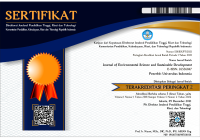Abstract
Population growth is always accompanied by an increase in waste generation. The issue of the increasing volume of waste becomes crucial if it is not balanced through proper handling efforts. The Provincial Government of DKI Jakarta through the Environment Agency of DKI Jakarta Province seeks to address the waste problem by constructing alternative facilities in the city’s waste processing facilities. The processing facilities referred to here are the Waste Power Generation or Intermediate Treatment Facility. The operational sustainability and the production output of the facility are influenced by the amount of waste supply as its raw material and are also influenced by the optimization of the transportation route of waste to the facility. The purpose of this research was to develop a model that can optimize the transportation route of waste from the source to the Intermediate Treatment Facility. The nearest neighbor method was to devise a truck travel route to serve the temporary waste shelter closest to the last visited location. The result of this research was obtained by route and trip that has new implications on garbage transportation which more optimize from the side of transport capacity, travel time, distance, and decrease from previous condition to the requirement of garbage truck procurement equal to 39.16%, fuel cost of 35.64%, human resources salary of 39.16%, and 35.64% reduction in greenhouse gas emissions. The implementation of the new routes and trips has a very positive impact in terms of the economic viewpoint to save operational costs, reduce the social impacts of delays in transporting waste from the sources, and reduce emissions from transportation operations.
Recommended Citation
Hermawan, Fahmi
(2018).
Optimization Of Transportation of Municipal Solid Waste from Resource to Intermediate Treatment Facility with Nearest Neighbour Method (Study on six Sub Sub District in DKI Jakarta Province).
Journal of Environmental Science and Sustainable Development, 1(1), 86-99.
Available at: https://doi.org/10.7454/jessd.v1i1.21






